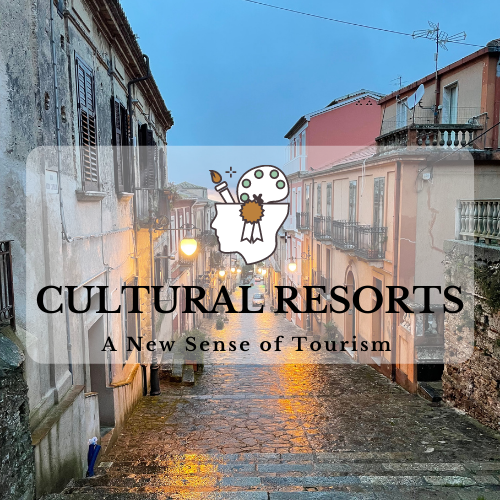Cultural Resorts. A New Sense of Tourism
Basic information
Project Title
Full project title
Category
Project Description
What about a place where tourism meets local culture, where tourists meet citizens? A place of exchange, connection, inclusion and requalification.
Originated from the deep gap between tourist and cultural industries in Italy, Cultural Resorts want to promote a new business model combining tourist resorts and cultural centers, trying to foster a new, sustainable sense of tourism.
Geographical Scope
Project Region
Urban or rural issues
Physical or other transformations
EU Programme or fund
Which funds
Description of the project
Summary
What about a place where tourism meets local culture, where tourists meet citizens? A place of exchange, connection, inclusion and requalification.
Originated from the deep gap between tourist and cultural industries in Italy, Cultural Resorts want to promote a new business model combining tourist resorts and cultural centers.
The idea was conceived with reference to both rural and urban areas, as a valid mean for the requalification of villages and rural areas, as well as for a more sustainable tourism in crowded cities (such as Venice, whose locals are gradually leaving the city because of unsustainable tourism). Specifically, the idea was conceived for Italy, where tourism is unbalanced: cities are crowded with unsustainable tourism while villages and rural areas are increasingly depopulating.
Following the need, duty and burden to rebalance one of the most productive industry (tourism) and to exploit one underestimated industry (culture) in Italy, the resorts will be conceived to host libraries, bookshops, exhibition spaces, a cinema, a theatre for ballet and performances, music facilities, most importantly spaces to connect tourists with local people and with the original local art and culture. All the exhibitions, collections and artists involved will be local hence contributing to communicate local culture and creativity. The activities will be built on the encounter between locals (as artists, cultural professional but also as audience themselves) and tourists.
The connection is needed to offer a deeper idea of local culture and communicate diversity but also to disseminate a more sustainable sort of tourism: a model of tourism that builds on local culture, traditions and creativity, and rises awareness on local culture.
Key objectives for sustainability
I am sure creative and cultural goods do generate critical thinking. At the same time, I think the most crucial tool to overcome environmental crisis is awareness. Cultural Resorts would be a significant tool to gather people (tourists and locals), to foster and communicate the fundamentals of environmental sustainability and circularity using cultural and creative media.
Overall, Cultural Resorts would have three impacts on environmental sustainability:
1) create awareness on locals and tourists through creative and cultural activities (exhibitions, performances, cinema, lectures), but also acting as a promoter of voluntary campaigns following the morals of the Clean Seas Plastic Challenge.
2) promote a new kind of sustainable tourism through focused activities on the impact of damaging tourism
3) use sustainable materials for every part of the Cultural Resort (and explain it to the guests)
4) develop education programs for local and tourist children
Key objectives for aesthetics and quality
Cultural Resorts are about aesthetic and quality of experience rather than functionality. The main objective is to combine the pure functionality of tourism and beach resorts with the quality of cultural centers.
Creativity and culture do enrich people's life. In turn, people do enrich contemporary artists' work and critical thinking. Connecting them is vital for our society, to develop critical thinking, inclusion, diversity, awareness.
Moreover, Cultural Resorts would represent a tool of requalification, bringing quality to rural and urban areas.
Key objectives for inclusion
Cultural Resort are about inclusion, just as cultural centers are. However, they combine two kind of public: locals and tourists, trying to communicate concepts of diversity and inclusion to both audiences. They foster public participation through a good communication strategy, which is focused on reaching all kind of audiences. The strategy to attract tourists will rely on the promotion of a different kind of resort, the strategy to attract locals will be based on the promotion of a new public space, where connections can be made.
Accessibility and affordability of cultural and creative activities will be guaranteed through public funds but also through a new internal funding system based on the revenues gained as a tourism resort. Services like restaurant, bars and library could be either externalized or not.
Just as malls do, a big QR code will be located inside the resort to gain public's opinions and feedback and to always co-create and develop the format based on customers' needs. A small reward (such as a discount at the library) will be guaranteed to those filling the form.
Physical or other transformations
Innovative character
Environmental sustainability, aesthetics/quality of experience, inclusion. The quality of experience (through cultural and creative activities) in this case represents the starting point to foster inclusion and environmental sustainability. As already mentioned, culture and creativity promote critical thinking, sense of belonging and awareness. Cultural Resort would be the mean to spread aesthetic and quality of experience among a wide public (tourists and locals) and to enhance exchanges and connections between people (again, tourists and locals) who would unlikely meet otherwise. For tourists, a new way to experience local culture, people and territories, that would sustain and foster sustainable tourism, with a return on awareness of environmental sustainability as well.

